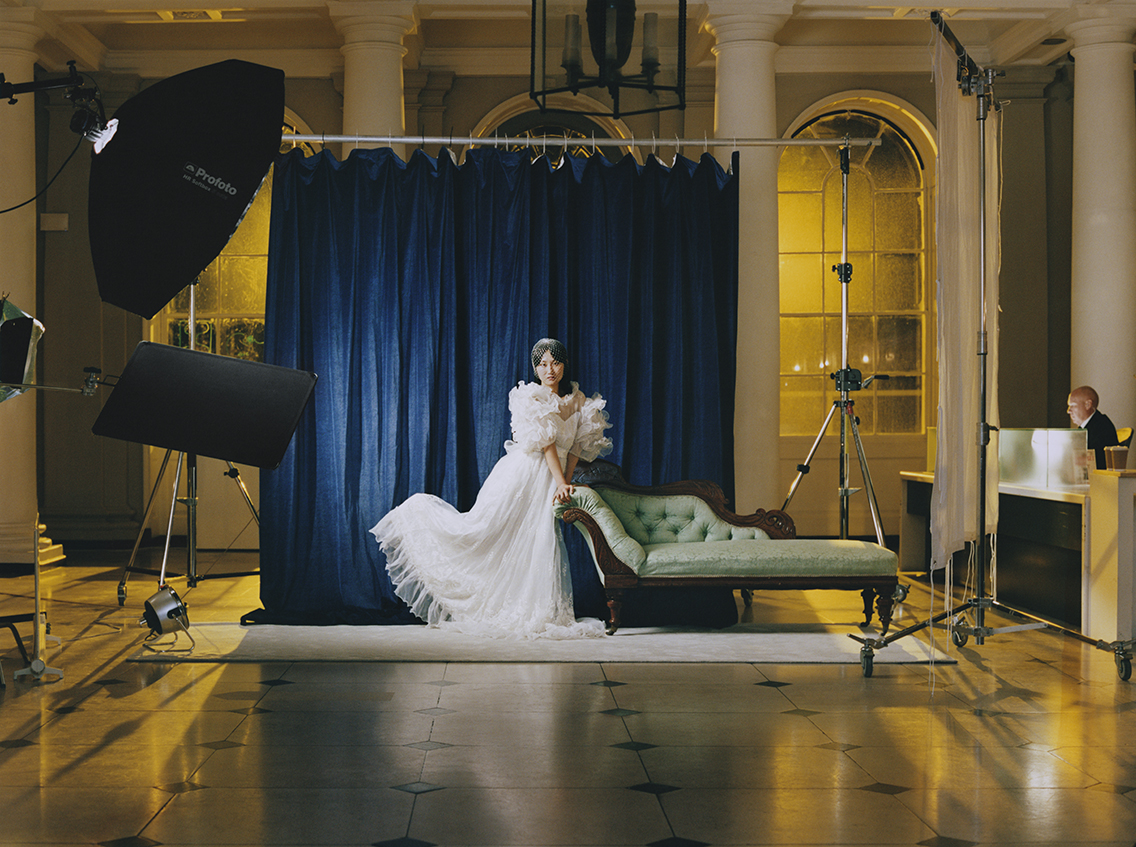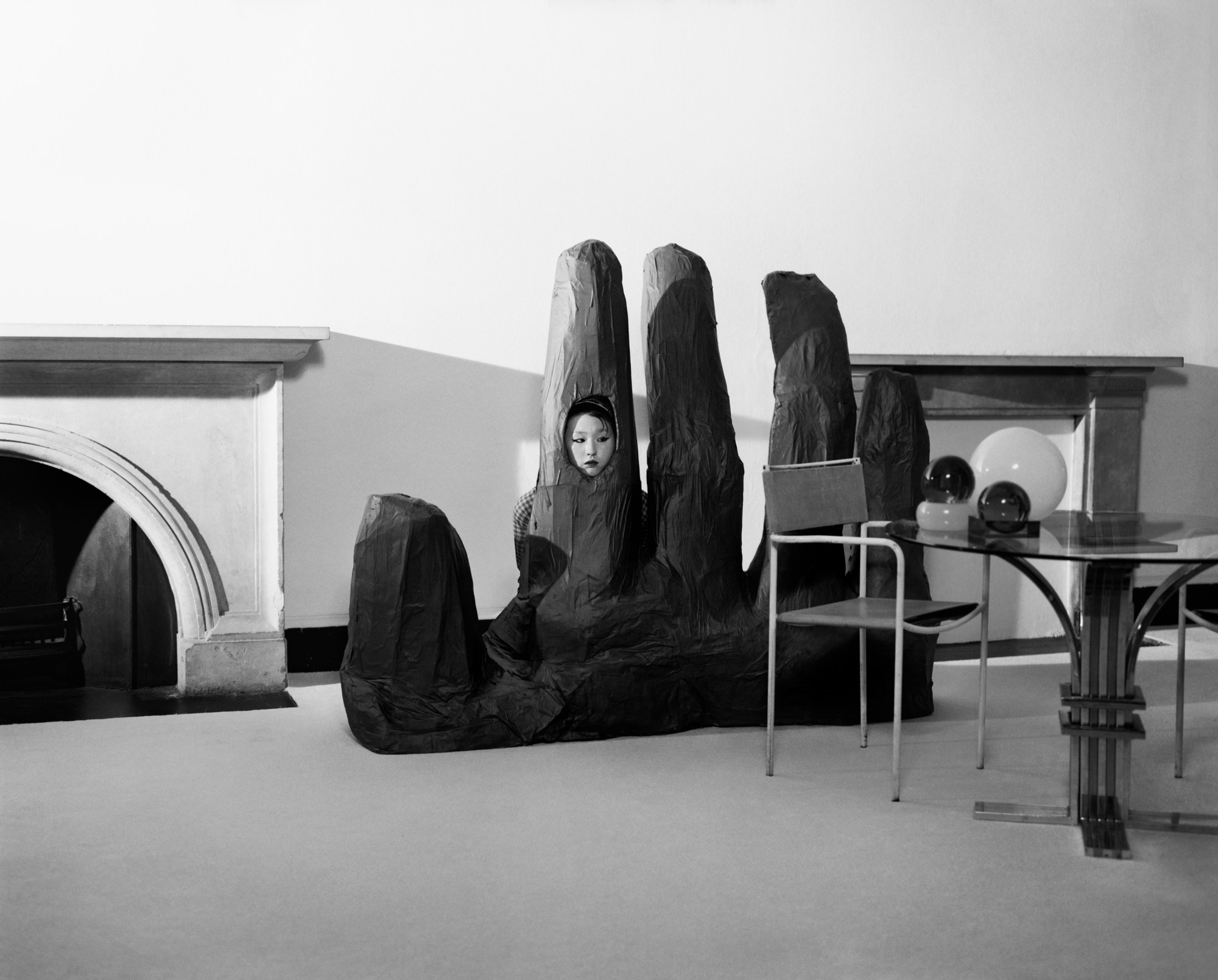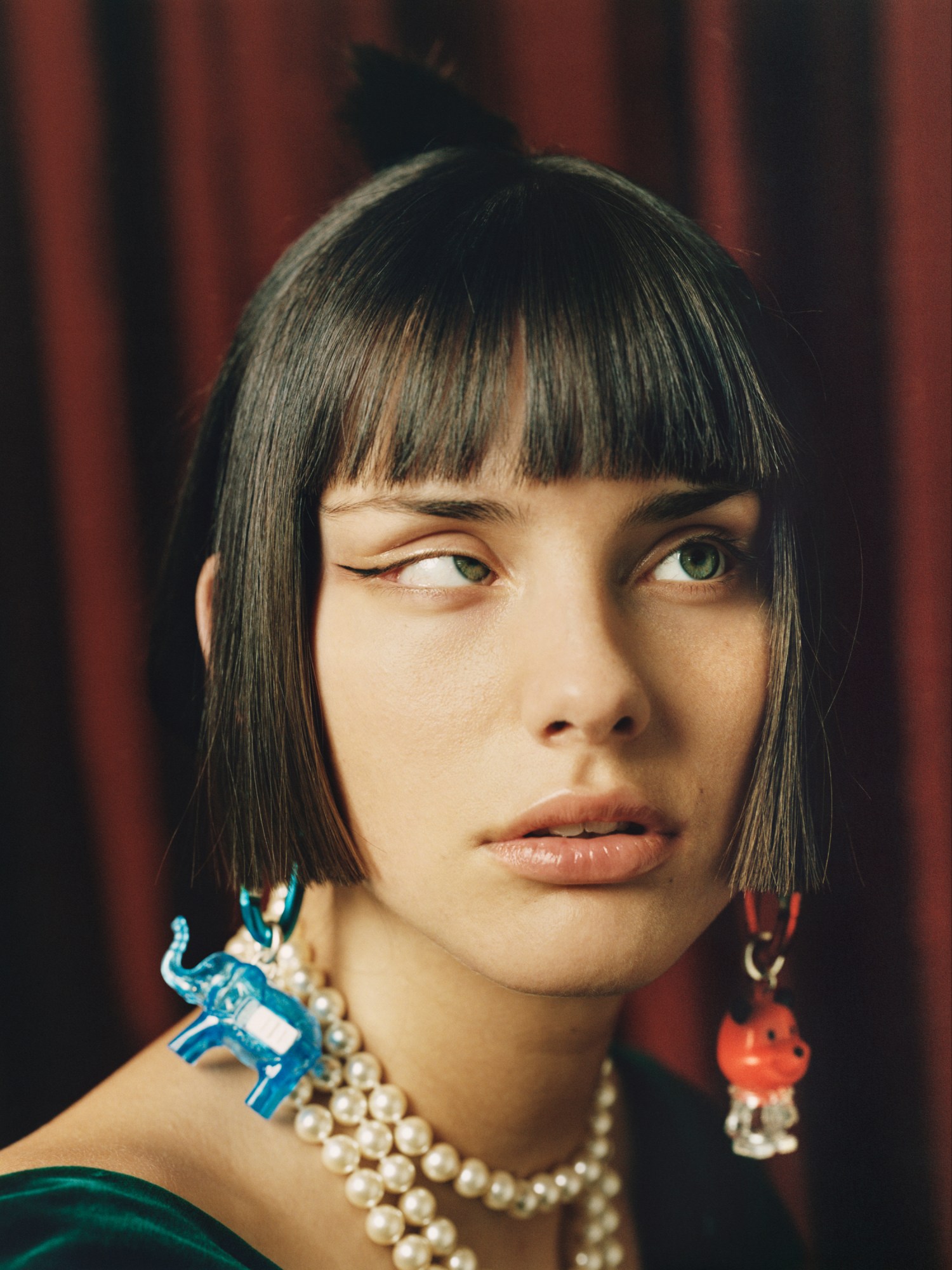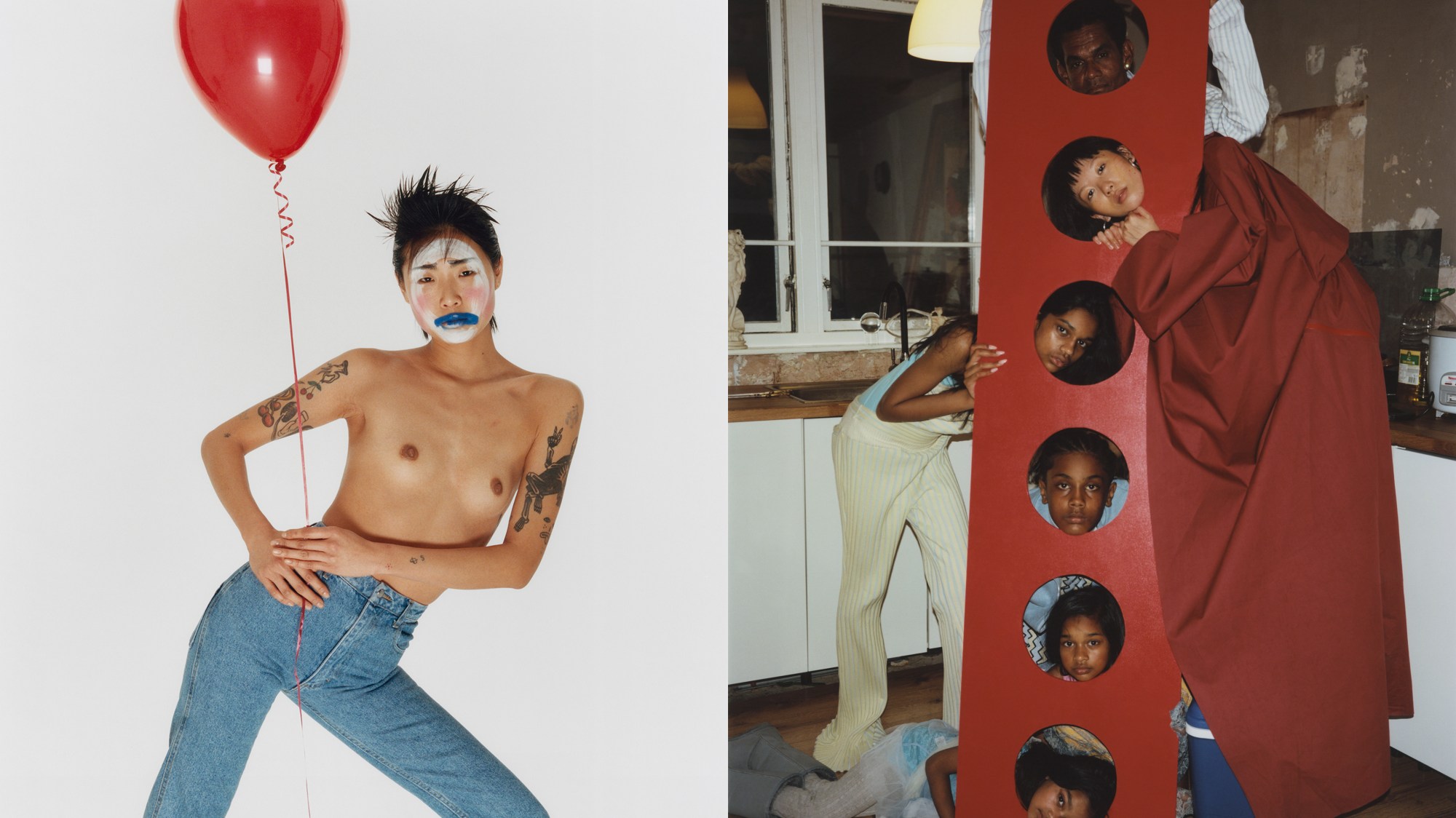It’s no understatement to say photographers Hanna Moon and Joyce Ng are creating some of the most thought-provoking fashion photography in the business right now. Born in South Korea and Hong Kong respectively and now based in London, the pair use their dual-heritage as a springboard to create powerful contemplations on identity and arresting stories about the intersection of cultural assimilation and celebration.
Having both worked individually with i-D — most recently on a story about British-Nigerian designer Mowalola’s debut collection (Joyce) and an eclectic fashion story starring Selena Forrest (Hanna) — as well as with a number of leading style publications, the two friends have joined forces on an exhibition that articulates their shared perspective. Commissioned by Somerset House, English as a Second Language responds directly to the museum’s historical setting with a series of images seeking to better understand Western aesthetics through a pan-Asian lens.

Tell us a bit about yourself and where you grew up…
Hanna: I was born in Daejeon, South Korea. It was a very quiet city and I didn’t really have much contact with art growing up. But I was always very interested in fashion. I would spend hours and hours browsing what to buy online. I moved to Seoul for a couple years to study when I was 19, then to London!
Joyce: 27, Virgo. I grew up in Hong Kong until I was 17, then I moved to London. I was temporarily in Canada with my parents, when a lot of Hong Kong residents panicked over the city being soon handed back to the PRC [People’s Republic of China] and falling under a communist rule. We moved back a few years later, when they realised we still had a few decades to go as a semi-self governed city. I grew up moving homes every few years and between Chinese-speaking schools and English-speaking schools. Growing up in Hong Kong was like growing up in a giant mall.
How and when did you get into photography?
Hanna: I moved to London about eight years ago, to study as an exchange student for a year at CSM. I actually had no idea what I was walking into. It was very new to me that the course wouldn’t ‘teach’ you much, it was more about guiding you to make your own work. Which I never really experienced studying in Korea. I had to take pictures to deliver the projects, and I was really enjoying it. I started working for Tyrone Lebon and I learnt a lot more of the technical side. Ever since then I have been taking pictures non-stop!
Joyce: I thought I was into graphic design, then production, then art direction, then casting before I set my focus on photography. It was at final year in Central Saint Martins when I tried photography.

Do you remember the first time a photographer’s work had a profound effect upon you?
Hanna: As I haven’t had much contact with art when I was in Korea, it was a whole new world to me when I first moved to London and started studying at CSM, with its library dedicated to art, fashion and photography. I can’t remember the specific work, but I remember having a huge crush on Linda Evangelista wearing suits for Vogue Italia by Peter Lindbergh.
Joyce: I didn’t grow up with the same type of visual or cultural stimulation I received during my London university years. The main visual reference was ads and tabloid covers at 7/11 and my mum’s weekly purchase of Ming Pao Weekly, with its amazing cultural supplement. I can’t pinpoint one photographer that ‘changed my life’. I credit my visual language to these commercial images and ‘non-highbrow images’ and people I watched back home everyday.
Did you study photography at university? What did you learn? Did you think it is worth it?
Hanna: I studied fashion communication. We had a B&W photography class during our second year though, which is where I developed my interest for analogue printing. I don’t think it’s necessary to study in a photography course personally, even though I haven’t actually experienced it. The reason why I think it’s unnecessary is that the technical side of photography is getting less and less important. I think it’s more about having your own vision.
Joyce: I studied fashion communication. What I learnt most was about myself. It was a journey for me, as a sheltered only child to becoming independent. It was 100% worth it, even though I was very intimidated by CSM for a while.

In an industry saturated with imagery, how do you keep your ideas new and fresh?
Joyce: By keeping my Instagram minutes low and sleeping enough. When I’m out of my house, I’m constantly people watching.
Film or digital? Do you have to spend huge amounts on equipment to make it?
Hanna: I started with film photography and I am more familiar with it. I also enjoy doing hand printing myself, love the physicality of it. But I’d love to explore more in digital as it has so much potential. Literally nothing is impossible with it. I do spend quite a big amount on equipments for shoots, but don’t think it’s necessary. I used to shoot with very minimal equipment because of money issues, and some of those early shoots are still my favourites!
Joyce: Film. No, I’m the queen of deals and frugality.
How do you balance creativity and commerciality?
Hanna: I think the key is that you always put your creativity as priority. And then commercial projects will follow. I think the industry is open to be experimental more and more, always looking for something new. So I don’t think the separation is complete necessity.
Joyce: I’m yet to find the final answer, as my editorial and commercial work is out of balance ATM.

What makes a compelling, emotive photo?
Hanna: A relationship with your subject. That’s why I love shooting my own friends so I can catch the intimacy between us.
Joyce: Something that breathes realness and foreignness at the same time.
Has the complete immersion of imagery online changed the way you think about, and research, photography?
Hanna: It definitely has made everything more convenient. I still go to a lot of book fairs, second hand book shops to find the gems and still enjoy collecting printed books. But I think the internet expanded the way of researching, you can go way further with your research if you have the right starting point. At the same time a lot of people would find the same information online and that information can be be recycled over and over again. Which means having your originality is only more important. These days I try to avoid having lots of reference images for my shoots for this reason.
Do you think iPhone photography has devalued or enhanced the photography industry?
Hanna: I think it’s a great thing. I have to fight to take better pictures than an iPhone with my film cameras. I always think it looks so nice when a stylist or someone else on set takes a picture on their phone. I often make a joke that I hope my pictures look better than theirs! But again it’s more about the idea or subjects of what you shoot, rather than the gear itself.
Joyce: I love phone photography. All this analogue snobbery is boring. It’s just the method of working. My favourite videos are on my iPhone 7S and my mum’s Huawei P20. I love it when my designer friend Rym comes to me with proposals of angles and compositions on her iPhone. I roll my eyes, but then think to myself, “Oh shit my photos better be as good, if not better”. When the stylist shows me their phone photos after the shoot, I often wonder why don’t we just put these in the edit?

How did the forthcoming exhibition English as a Second Language come about?
Hanna: I got to know Shonagh, the curator, through her previous exhibition Posturing. Me and Joyce were both part of the exhibition and I think she became interested in our work through it. I think she always has been interested in the meaning of beauty and diversity in fashion.
What story are you hoping to tell with it?
Hanna: I am not super ambitious to tell the big story with it. I have produced some new work in the new context I got given. I think the most personal work will reach out to audience the most rather than trying to give big meaning into my work. I think my personality and identity is the message of our exhibition. I just tried to produce the work I think it best represents me. Asian, female, lesbian, photographer. Das me!
Many of the most exciting photographers right now have dual-heritage and grew up between different countries. What do you think it is about this experience that lends itself so well to photography?
Joyce: This is so true. I’m spoiled to have this upbringing. My parents never got on an airplane until their 20s. There’s this very common Chinese saying, “Reading thousands of books is not as good as traveling thousands of miles.” Growing up in Hong Kong was just like having a yin yang soup base hotpot. It elevates the whole meal experience with different flavour, but every once in awhile you get confused as to which soup you want to cook your sliced eel in and you get shouted at for double dipping at the wrong soupbase. It wasn’t until I went home after my uni years that I wanted so badly a jade bangle. I yearn for my roots more and more as I grow older.

Credits
Photography Hanna Moon and Joyce Ng
